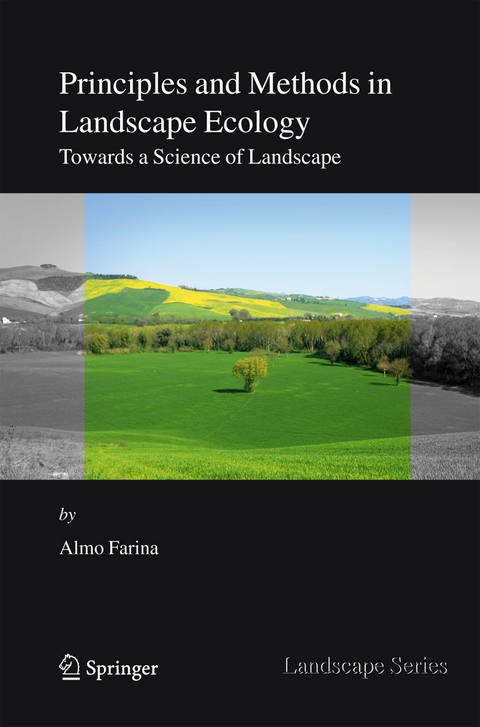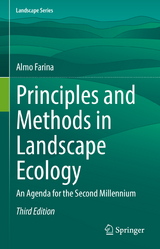
Principles and Methods in Landscape Ecology
Springer-Verlag New York Inc.
978-1-4020-3327-8 (ISBN)
- Titel erscheint in neuer Auflage
- Artikel merken
Landscape ecology is an integrative and multi-disciplinary science and Principles and Methods in Landscape Ecology reconciles the geological, botanical, zoological and human perspectives. In particular ,new paradigms and theories such as percolation, metapopulation, hierarchies, source-sink models have been integrated in this last edition with the recent theories on bio-complexity, information and cognitive sciences.
Methods for studying landscape ecology are covered including spatial geometry models and remote sensing in order to create confidence toward techniques and approaches that require a high experience and long-time dedication.
Principles and Methods in Landscape Ecology is a textbook useful to present the landscape in a multi-vision perspective for undergraduate and graduate students of biology, ecology, geography, forestry, agronomy, landscape architecture and planning. Sociology, economics, history, archaeology, anthropology, ecological psychology are some sciences that can benefit of the holistic vision offered by this texbook.
Almo Farina is Professor of Ecology at the Urbino University, Faculty of Environmental Sciences (Urbino, Italy).
Prefaces.- Glossary and Acronyms.- 1. 1.1 Introduction. 1.2 The contribution of different disciplines to the creation of a paradigmatic framework in landscape ecology. 1.3 Definitions of landscape (A gallery). 1.4 An epistemological approach to the landscape. 1.4.1 The nature of landscape. 1.4.2 The role of landscape. 1.4.2.1 Landscape as domain. 1.4.2.2 Landscape as system. 1.4.2.3 Lanscape as unit. 1.5 The description of landscape. 1.5.1 The 'ecological landscape'. 1.5.1.1 Principles of landscape classification. 1.5.2 The cognitive landscape. 1.5.2.1 Spacing - The perception of the landscape. 1.5.2.2 Space and memory. 1.5.2.3 Embodiment and cognition. 1.5.2.4 Safety, aesthetic landscape, amenity. 1.5.2.5 Topographic prominence, the visual landscape. 1.5.2.6 The psychological landscape. 1.5.2.7 Mistery in landscape. 1.5.2.8 Behavioral ecology and landscape ecology. 1.5.2.9 Information landscape. 1.5.2.10 The eco-field hypothesis. 1.5.2.11 The sound-scape. 1.5.2.12 Animal movements in the landscape. 1.6 Summary. 1.7 Suggested readings. 1.8 References.- 2. Theories and models Iicorporated in the landscape ecology framework. 2.1 Introduction. 2.2 Complexity. 2.2.1 The emergence of complexity. 2.3 Information. 2.3.1 The information as universal coin. 2.3.2 Information as measure of probability. 2.3.3 Information-processing performance of ecosystems. 2.4 Cognition and autopoiesis. 2.5 Semiotic, bio and eco-semiotic. 2.6 The hierarchy theory and the structure of the landscape. 2.7 The percolation theory. 2.8 The metapopulation. 2.8.1 Introduction. 2.8.2 Dispersion. 2.8.3 Examples of metapopulation structure. 2.8.4 Metapopulation and conservation biology. 2.9 The systems source-sink. 2.9.1 Definition. 2.9.2 Implications of the source-sink model. 2.9.3 Pseudo-sinks. 2.9.4 Traps. 2.9.5 Source-sink in time or multiple source-sink model. 2.9.6 Stable maladaptation. 2.9.7 Source-sink dynamic and conservation issues. 2.9.8 Concluding remarks. 2.10 Suggested readings. 2.11 References.- 3. Scaling patterns and processes across landscapes. 3.1 Introduction. 3.2 Moving across scales. 3.3 Some definitions. 3.4 Scaling the landscape. 3.5 Change of scale perception. 3.6 The multiscale option. 3.7 The importance of the parameters at the different scales. 3.8 Grain size and scaling. 3.9 Assessing landscape scale of analysis. 3.10 Examples of scales in landscape and in ecological related disciplines. 3.10.1 Scaling the quaternary landscape. 3.10.2 Scaling patterns: The catchment scale. 3.10.3 Scaling abiotic processes: Hydrological processes and scales. 3.10.4 Scaling evidences in animals. 3.11 Suggested readings. 3.12. References.- 4. Emerging processes in the landscape. 4.1 Introduction. 4.2 Disturbance. 4.2.1 Introduction. 4.2.2 Snow cover, an example of abiotic disturbances. 4.2.3 Human disturbances. 4.2.4 Gap disturbances in forest. 4.2.5 Gaps in savanna. 4.2.6 Fire disturbance in dry landscapes. 4.2.7 Pathogens disturbance. 4.2.8 Animal disturbance. 4.3 Fragmentation. 4.3.1. Introduction. 4.3.2 Scale and patterns of fragmentation. 4.3.3 Community composition and diversity in fragments. 4.3.4 Species, guilds and fragmentation. 4.3.5 Habitat fragmentation and extinction. 4.3.6 Predation and fragmentation. 4.3.7 Island size and isolation, a key to understand fragmentation. 4.3.8 Habitat fragmentation and animal behaviour. 4.3.9 Measuring the effects of fragmentation. 4.3.10 The complexity and unpredictability of fragmented landscape. 4.4 Connectivity, connectedness and corridors. 4.4.1 Introduction. 4.4.2 Corridors: Structure and functions. 4.5 Soil landscape and movement of water and nutrients across landscape. 4.5.1 Introduction. 4.5.2 Soil landscape. 4.5.3 The role of riparian vegetation in nutrient dynamics. 4.5.4 Origin, composition and flux of dissolved organic carbon in a small watershed. 4.5.5 Leaf litter movements in the landscape. 4.5.6 Spatial patterns of soil nutr
| Erscheint lt. Verlag | 6.9.2006 |
|---|---|
| Reihe/Serie | Landscape Series ; 3 |
| Zusatzinfo | XXII, 412 p. |
| Verlagsort | New York, NY |
| Sprache | englisch |
| Maße | 155 x 235 mm |
| Gewicht | 890 g |
| Themenwelt | Naturwissenschaften ► Biologie ► Ökologie / Naturschutz |
| ISBN-10 | 1-4020-3327-3 / 1402033273 |
| ISBN-13 | 978-1-4020-3327-8 / 9781402033278 |
| Zustand | Neuware |
| Haben Sie eine Frage zum Produkt? |
aus dem Bereich



